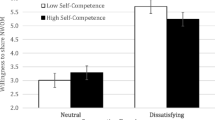Abstract
This research examined the relation between self-relevance and word-of-mouth (WOM). The results of two studies suggest consumers are more likely to provide WOM for products that are relevant to self-concept than for more utilitarian products. There was also some indication that WOM was biased, in the sense that consumers exaggerated the benefits of self-relevant products compared to utilitarian products. Finally, self-relevance had a greater impact on WOM in individualist cultures than collectivist cultures, consistent with differences in the way self-concept is typically construed by these groups. Implications for marketing strategies concerning WOM are discussed.
Similar content being viewed by others
References
Allport, G.W., & Postman, L.J. (1946). The Psychology of Rumor. Cambridge, Massachusetts: Harvard University.
Alsop, R. (1984). Study of Olympics Ads Casts Doubts on Value of Campaigns. Wall Street Journal, December 6.
Barone, M.J., Shimp, T.A., & Sprott, D.E. (1999). Product Ownership as a Moderator of Self-Congruity Effects. Marketing Letters, 10(1), 75–85.
Belk, R.W. (1988). Possessions and the extended self. Journal of Consumer Research, 15(September), 139–168.
Bem, D.J., & Allen, A. (1974). On Predicting Some of the People Some of the Time: The Search for Cross-Situational Consistencies in Behavior. Psychological Review, 81(6), 506–520.
Chaiken, S., & Trope, Y. (1999). Dual-Process Theories in Social Psychology. New York, NY: Guilford Press, xiii.
Chen, S., Shechter, D., & Chaiken, S. (1996). Getting at the Truth or Getting Along: Accuracy—-Versus Impression-Motivated Heuristic and Systematic Information Processing. Journal of Personality and Social Psychology, 71, 262–275.
Day, G.S. (1971). Attitude Change, Media and Word of Mouth. Journal of Advertising Research, 11(6), 31–40.
Dichter, E. (1966). How Word-of-Mouth Advertising Works. Harvard Business Review, November-December, 147–166.
Fazio, R. H., & Towles-Schwen, T. (1999). The MODE model of attitude-behavior processes. In S. Chaiken and Y. Trope (Eds.), Dual-process Theories in Social Psychology. (pp. 97–116). New York, NY: Guilford Press.
Gitelson, R., & Crompton, J. (1983). The Planning Horizons and Sources of Information used by Pleasure Vacationers. Journal of Travel Research, 21(3), 2–7.
Heine, S. J., et al. (1999). Is There a Universal Need for Positive Self-Regard?. Psychological Review, 106(4), 766–794.
Hofstede, G. (1991). Culture and Organizations —- Software of the Mind. McGraw-Hill.
Holbrook, M. B., & Hirschman, E. (1982). The Experiential Aspects of Consumption: Consumer Fantasies, Feelings, and Fun. Journal of Consumer Research, 9(2), 132–140.
Holmes, J.H., & Lett, Jr., J.D. (1977). Product Sampling and Word of Mouth. Journal of Advertising Research, 17(5), 35–40.
Leary, M.R., & Kowalski, R.M. (1990). Impression Management: a Literature Review and Two-Component Model. Psychological Bulletin, 107(1), 34–47.
Lutz, R., & Reilly, P. (1973). An Exploration of the Effects of Perceived Social and Performance Risk on Consumer Information Acquisition. In Proceedings, Fourth Annual Conference, The Association for Consumer Research, pp. 393–405.
Markus, H.R. & Kitayama, S. (1991). Culture and Self: Implications for Cognition, Emotion, and Motivation. Psychological Review, 20, 224–253.
Markus, H.R., Kitayama and Nurius, P. (1986). Possible Selves: The Interface between Motivation and the Self-Concept. In K. Yardley and T. Honess (Eds.), Self and Identity. (pp. 157–172). New York: John Wiley & Sons Ltd.
Mizerski, R.W. (1982). An Attribution Explanation of the Disproportionate Influence of Unfavorable Information. Journal of Consumer Research, 9(December), 301–310.
Richins, M.L. (1994). Special Possessions and the Expression of Material Values. Journal of Consumer Research, 21(December), 522–533.
Schlenker, B.R. (1980). Impression Management: The Self-Concept, Social Identity, and Interpersonal Relations, Monterey, CA: Brooks/Cole.
Sengupta, J., Dahl, D.W., & Gorn, G.J. (2002). Misrepresentation in the consumer context. Journal of Consumer Psychology, 12(2), 69–79.
Silverman, G. (1997). How to harness the awesome power of word of mouth. Direct Marketing, 60(7), 32–37.
Swan, J.E., & Richard L.O. (1989). Postpurchase communications by consumers. Journal of Retailing, 65(4), 516–533.
TARP (1979). Measuring the Grapevine: Consumer Response and Word-of-Mouth. Atlanta, GA: The Coca-Cola Co.
Walker, C.J. & Beckerle C.A. (1987). The Effect of State Anxiety on Rumor Transmission. Journal of Social Behavior and Personality, 2(3), 353–360.
Author information
Authors and Affiliations
Corresponding author
Additional information
This paper is based on the first author’s doctoral dissertation
Rights and permissions
About this article
Cite this article
Chung, C.M.Y., Darke, P.R. The consumer as advocate: Self-relevance, culture, and word-of-mouth. Market Lett 17, 269–279 (2006). https://doi.org/10.1007/s11002-006-8426-7
Issue Date:
DOI: https://doi.org/10.1007/s11002-006-8426-7




